Вестник Волгоградского государственного университета. Серия 2: Языкознание @jvolsu-linguistics
Статьи журнала - Вестник Волгоградского государственного университета. Серия 2: Языкознание
Все статьи: 1663
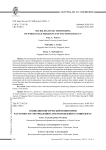
Sociolinguistic monitoring of word usage frequency of youth sociolect
Статья научная
The current paper describes the lexical units ofyouth sociolect and is aimed at monitoring youth speech. Special attention is given to heterogeneous social factors that influence the word usage in youth sociolect and involve micro-and macrosociolinguistic pilot projects on frequency occurrence of English words in a multicultural society. Miscrosociolinguistic analysis was focused on societal and gender differences in youth sociolect. The initial stage of the macrosociolinguistic monitoring included the questionnaire development, setting the boundaries of a sociolinguistic survey and the number of lexical items under consideration. The second step in the project was monitoring itself. Finally, the results of the monitoring were analyzed. The studywas carried out through an online questionnaire, face-to-face and remote interviewing, with native English speakers and speakers ofother languages from different countries and regions. The monitoring of usage frequency demonstrated that a limited number of English lexical units are used in interpersonal and professional communication; the other part of words presents a diverse picture. The respondents involved in professional activity tend to demonstrate more tolerance to the youth sociolect than ordinary people. The analysis proved the point about the heterogeneous character of sociolect usage by youth and its dependence on the sphere of communication.
Бесплатно
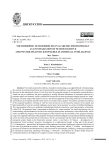
Статья научная
The article analyzes the problems of academic emotionology as an applied branch of emotionology (the science of emotions) based on the use of sociomorphic neuromodeling, viewed through the prism of academic discourse in the educational system. For the first time, the proposed concept of sociomorphic neuromodeling is aimed not only at explaining, but also at applying a socially inherited mechanism of emotional response in a particular ethnic environment, which is reflected in the specifics of neuro-psychophysiological signals as a "deep" language. The main angle of the analysis is due to a non-discrete approach to assessing emotivity in communication and emotions in the speech and behavioral matrix of a modern native speaker. The authors consider the evidence of the proposed hypothesis verifying it with the work carried out on the emotivity analyzer of the speech and behavioral profile of a carrier a natural intelligence carrier and a "smart assistant" as a carrier of artificial intelligence. This representation allows us to undertake methodological holism towards the visual representation of emotions within NLP. The proposed "deep" neurocognitive designer of a "smart assistant" for social engineering rests on understanding neuromodulators activities as the neuro-psycholinguistic mechanisms of the human brain, which makes available the prospects for the development of the analyzer and the possibility of the proposed interface usage. The suggested refinement of the gradation of natural emotional intelligence and emotional artificial intelligence solves the issues of the general theory of emotions, which is an important step for further development of robotic humanoid systems based on the biomimetic concept. Authors' contribution. M. Talanov - development of a bioinspired "smart assistant" program, development of a mathematical model, writing part of the project; I.S. Karabulatova - general idea, development of the gradation of emotional intelligence, analysis of the history of the issue of psychometric research, writing a part, drafting instructions, editing; V. Erokhin - development of processes for biosensors and bioelectronics in the framework of neuromorphic computing; conducting experiments for bioinspired computing; clarifying terminology; J. Vallverdú - development of a project design using new intellectual solutions, development of a cognitive model, writing of a part of the project.
Бесплатно
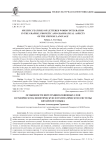
Статья научная
This paper is devoted to the specific features of lettered words’ integration in the graphic, phonetic and grammatical aspects of the Chinese language. The author has analyzed a number of local and foreign studies, covering the main patterns of the lettered words’ integration. Based on Liu Yongquan’s studies, it was concluded that it’s important to strictly follow letters’ case. The case difference can distinguish semantics of different lettered words. Native Chinese speakers with high linguistic competence are able to recognize various lettered words in print, but they may not know how to read them out loud. Therefore, the pronunciation of lettered words is associated with a number of issues: the choice of pronunciation standard, the differentiation of initialisms and acronyms, the choice which syllable to stress. Based on the results of previous research, different ways of how borrowed lettered words respond to the grammatical norms of the Chinese language were identified. The empirical analysis was performed with lettered words extracted by the method of continuous sampling from lexicographic sources. Using the cases described in the paper, the author has proved that in addition to such word-formation processes as compounding, semi-affixation, syntactic and morphological transposition, lettered words can also be formed and transformed with morphological contraction.
Бесплатно
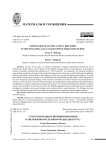
Strategies of manipulative rhetoric in English-language business media discourse
Статья научная
The aim of the study is to identify manipulative strategies implemented through the use of collocations, cliches, idioms, and set phrases in the English-language business media discourse. A quantitative analysis of samples collected from publications in "The Economist" was conducted. The research hypothesis proposes that manipulative strategies in the English-language business discourse are realized through the deliberate choice of collocations, cliches, idioms, and set phrases, which serve as tools for shaping public opinion. The study identified five manipulative strategies. It was established that manipulation through imagery-based expressions is the most frequently employed strategy, while evaluative assessments of factual content and manipulation by criticism are less frequent. The least utilized strategies are manipulation through antithesis and generalization, manipulation via vague or euphemistic language constructions. The research confirmed that collocations, cliches, idioms, and set phrases are extensively used in the English-language business media discourse to implement manipulative strategies, and several strategies may be joined within a single utterance. The findings may have scientific implications, particularly for scholars and professionals in media and business communication.
Бесплатно
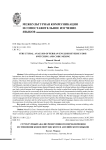
Structural analysis of persian-english reverse code-switching and code-mixing
Статья научная
Code-switching and code-mixing are considered dynamic conversational phenomena in interpersonal interactions, that is an alteration between two or more languages, dialectal variants, language registers, and it is an effective communicative strategy which Persian-English bilinguals consider a genuine thing in their ordinary speech practice. The focus of the present study is on the structural analysis of reverse code-switching between Persian and English that are known to be referred to two typologicallydifferent languages. Participants of the present research, all late bilinguals, reported on frequent use of code-switching (CS) and code-mixing (CM) in everyday language practice. CS/CM is quite normal and frequent among Iranian bilinguals, especially in informal settings where bilingual speakers can freely switch between their languages. Furthermore, the results revealed that Iranian bilinguals switch from English to Persian and in verso mostlyat the lexical and the phrasal levels (intrasentential switching mode), but less frequently at the clausal or the sentence level (intersentential switching mode). The research states that there are some restrictions on inserting English verbs into the Persian syntactic frame: the Persian language is thought to be the matrix language and the preverbal part comes from English as the embedded language, such incongruity between the morphosyntactic structure and the verbal system of the Persian and English languages impose some constraints on the occurrence of switching codes between the pair of the languages under study.
Бесплатно
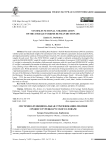
System-functional stratification of the average Turkish-Russian dictionary
Статья научная
The study is aimed at stratifying Rosa Yusipova’s Turkish-Russian Dictionary (2005) in accordance with the system and functional weights of its constituent words. The method is a parametric lexicon analysis (PLA), developed and tested byscientists of Voronezh State University. PLA involves identifying four particular parametric weights for each word. This is the FUNCTIONAL weight (F-weight is indirectly estimated by the length of the word), the PARADIGMATIC weight (P-weight is estimated by the number of synonyms), SYNTAGMATIC weight (C-weight is estimated by the number of phrases and utterances with this word) and EPIDIGMATIC weight (E-weight is estimated by the number of meanings of a word in the dictionary). For each of the 4 parameters, partial core, counting at least 1000 words, was allocated. The words presented in all 4 particular cores, entered a Small parametric core. Words presented in 3 particular cores entered an Average parametric core, words represented in 2 particular parametric cores - a Large parametric core and words presented in 1 particular parametric core entered the core of the Dictionary. Words that are not presented in any particular parametric core make up the Periphery of the Dictionary. The analysis revealed the words of all 4 cores of the dictionary: Small - 140 words, Middle - 630, Large - 3234, the core of the Dictionary - 6861 and the Periphery of the Dictionary counts 18236 words. The dominant (the most important word in the dictionary) was the word iş ‘work, labor’, and the vice-dominant - the word üst ‘the top’.
Бесплатно
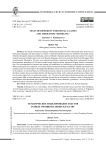
Texts of different emotional classes and their topic modeling
Статья научная
The article is devoted to studying verbalization specifics of various emotional states in the texts in the Russian language with the purpose to confirm or refute the hypothesis that texts of different emotional classes reflect the denotative situation not identically, which is reflected in thematic specifics and lexical content. The research material consisted of eight corpus texts in the Russian language, which were extracted from the public pages of the social network VKontakte. The texts were selected according to emotional hashtags that corresponded to eight basic emotions, according to H. Lцvheim’s model: anger, surprise, shame, enjoyment, disgust, distress, excitement, fear. The correspondence of emotion and hashtag was established in a preliminary psycholinguistic experiment. While analyzing the text collection, we used the method of computer thematic modeling to identify statistically non-random groups of words (topics). We applied the BERTopic neural network model to the collected data. As a result of the analysis, it was found that texts of 8 emotional classes contain an uneven number of topics, despite the fact that their number does not correlate directly with the amount of data: with a relatively small amount of data, there may be many topics, but in a voluminous corpus - few. The sets of words (tokens) that make up each non-random group (topic) differ in each subcorpora, reflecting the specifics of the denotative situation, which is formed under the influence of the emotional state of the speaker. The idea of diverse thematic “granularity” of texts of different emotional classes is theoretically justified.
Бесплатно
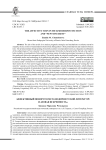
The Affective Turn in Metamodernist Fiction and “New Sincerity”
Статья научная
The aim of the article is to analyze pragmatic strategies and mechanisms to enhance narrative empathy, the key notion of metamodernist fiction that distinguishes it from postmodernist and modernist literary texts. The article postulates foregrounding of emotivity markers in metamodernist texts as a linguistic manifestation of the cultural logic of "new sincerity" in the contemporary fiction that is characterized by the lack of an explicit ludic modality of postmodernist fiction and by stressing means of producing emotional resonance on the part of the reader and their active perspective-taking. The article makes an original contribution to cognitive stylistics, multimodal studies and narratology by hypothesizing polyphony of narrative "voices", second-person narrative and visual foregrounding as effective pragmalinguistic tools of triggering emotive and cognitive empathy that increases reader's immersion in metamodernist fictional worlds. Using the novels by M. Porter and J. Egan, the short stories by J.S. Foer and D. Eggers as its case studies, the article proves the relevance of viewing the "new sincerity" concept as a driving force behind the authorial empathy towards fictional characters, which enhances emotionogenic potential of metamodernist fiction and contributes to reader's engagement with modeled emotive situations. The findings of the research testify to the importance of further research into "new sincerity" and potential mechanisms of inducing reader's empathy which is justly considered a powerful instrument for promoting social interaction, helping readers of all ages to inhibit aggression and develop understanding of others' motives, emotions and desires.
Бесплатно
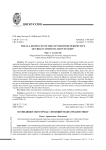
The all-seeing eye ofthe city from the perspective of urban communication studies
Статья научная
The research is carried out from the perspective of urban communication studies and uses the analytical sociolinguistic framework, which provides an opportunity to reveal the role of different semiotic signs in creating the image of a big city as an existential space. The paper focuses on surveillance as a common communication practice and investigates the system of Russian semiotic signs surrounding a citydweller as an object of surveillance. Signs construct the communicative situation of surveillance, which includes a subject, object, place, time, aim of surveillance and the consequences of actions seen as forbidden or undesirable. An important place in the study belongs to the notion of social visibility, which acquires a new meaning in the context of the research. The subjects of surveillance are unidentified representatives of power, whereas its objects are common citizens. Semiotic signs reflect the asymmetry of the social relationship between them (the subject of surveillance is invisible, the object is visible; the state demonstrates the paternalistic attitude towards its citizens). The modality of the message reflects the type of relationship between the subject and the object of surveillance and its social dynamics. The findings indicate that semiotic signs connected with surveillance become a powerful means of social stratification and regulate social relations in Russian urban discourse.
Бесплатно
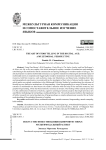
The art of storytelling in the digital age: a multimodal perspective
Статья научная
Using Dan Brown’s Wild Symphony , Craig Silvey’s The Amber Amulet , and Jon McGregor’s In Winter the Sky as its case studies, this article attempts to explore a number of mechanisms and strategies contributing to the multimodal fiction construction and posing challenges for modern readers of all ages. The article proposes to examine multimodal resonance as a cognitive mechanism enhancing the emotional impact of multimodal stories on recipients and triggering the receptive mechanism of narrative empathy. Various semiotic resources, both free resources, such as photos, maps, and illustrations, and bound ones, including font types and typographical experiments, are analyzed from the standpoint of their role in fictional world creation. The article makes an original contribution to the Multimodal Stylistics Studies by hypothesizing the relevance of identifying two distinctive mechanisms of foregrounding: visual foregrounding as a range of formal ways to construct a multimodal text that focuses the reader’s attention with the help of free semiotic resources, and graphic foregrounding, which has bound semiotic resources at its heart. The findings of the research prove that it is the combination of elements of stylistic, cognitive and linguo-semiotic analyses that might provide a new and effective methodologyfor interpreting a multimodal literary text. The overall outcome testifies to the importance of further research into varied mechanisms of foregrounding as a complex phenomenon essential for our better understanding of the embodied character of reading.
Бесплатно
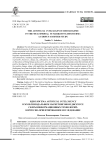
Статья научная
The article focuses on investigating the specifics of the Artificial Intelligence (AI) ideologeme in the website discourse of software vendors. The material of the study is the website discourse of Microsoft . The linguo-conceptual and discursive analyses have resulted in identifying the most frequent lexemes in dictionary entries and constructing the nominative field of the AI concept. We have carried out a corpus-assisted study of the linguistic representation of the AI ideologeme in the Microsoft discourse using AntConc and extracted keywords and collocations, including metaphorical ones, which make the ideologeme explicit through keywords such as responsible , businesses , change , etc., collocations: AI-ready culture , AI-human partnership , etc., metaphors based on the actions of living beings such as drive , dive , etc. The keywords and collocations create the intention-driven positive ideologeme of AI as a phenomenon regulated by competent bodies and empowering businesses to drive the positive change, along with amplifying the capabilities of human beings. The nonverbal means of the AI ideologeme have been described within the representative and interactive dimensions such as pictures of living beings, colors of nature such as green and blue, and metaphorical perspectives contributing to the discursive affinity of AI and nature. The corpus-assisted study has resulted in identifying the discursive representation of the AI ideologeme which is different from that of the dictionary entries describing AI as a machine capability to copy the human behavior.
Бесплатно
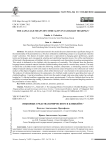
The language means of comicality in clickbait headings
Статья научная
The analysis of material presented in the media discourse demonstrates significant changes in the intentionality of the journalistic text, which are reflected in establishing contacts so as to grab and retain the reader’s attention. This feature of modern media text is represented in changing genre preferences, speech tactics and strategies, and, consequently, selecting and combining linguistic means. One of the manifestations of this trend is the phenomenon of clickbait, which is a communicative act of promising to continue communication. This article is dedicated to the clickbait with the semantics of comicality. The collected from the Russian-language Internet research material includes clickbait headings that promise a certain funny content. The study revealed that a clickbait model includes the following semantic components: a stimulating utterance of the subject of speech seeking to involve the reader in the humorous nature of hypertext; the verbal and non-verbal markers of the object of laughter; markers, which reflect Internet user’s involvement in the communicative act. The analysis of relationship between the components of a clickbait model resulted in specifying four types of clickbait headlines: 1) narrative headlines, which invite the reader to laugh what some other readers have already laughed at; 2) offering headlines suggesting some comic entertainment; 3) allusive clickbaits that hint on the possibility to continue amusing reading; 4) nominative clickbaits, which name the expected laughing reaction to the presentation of some objects.
Бесплатно
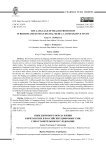
The language of health promotion in British and Russian digital media: a comparative study
Статья научная
The research explores the language of health promotion used in Health matters and Tak zdorovo - the national healthcare websites of the UK and Russia . The objective is to assess readability of the British and Russian texts as well as to reveal language properties and cultural implications of health promotion in national digital media. The comparative design of the study involves qualitative (contextual and interpretative) and quantitative (Compleat Lexical Tutor v.8.5 and Flesch-Kincaid grade) methods. The topic distribution results show that physical activity , healthy eating and weight control , tobacco smoking , alcohol dependence , mental health are raised in both cultures, however, the British corpus puts more emphasis on mental health issues compared to the Russian one. There are differences in ‘positive' vs ‘negative' approach in covering alcohol consumption issues. The findings on readability reveal higher rates of lexical density and lexical variety in the Russian corpus in comparison to the British one. However, the overall lexical coverage and readability index in the British (K-3) and Russian corpora (SIS - 8.68) are equally low, which means that the language of health promotion in both cultures is easy to understand. The Russian language of advice demonstrates frequent use of imperatives. The British corpus employs less categorical recommendation forms including modal verbs, create partnering communication styles and demonstrate a higher use of visual forms of health promotion. The findings revealing differences in rhetoric strategies (rational reasoning in British digital media vs emotional reasoning in Russian digital media) can be attributed to national and cultural implications.
Бесплатно
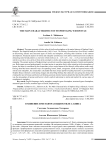
The main characteristics of stephen king’s idiostyle
Статья научная
The paper presents stylistic value of simile and metaphor as the major features of Stephen King’s idiostyle. The linguistic analysis of some novels (1408, Carrie, The Shining, Dreamcatcher, Dead Zone) is aimed at discovering sematic and structural types of simile and metaphor, revealing their functions in the content development. Structural analysis of simile and metaphor constituency in the above mentioned novels resulted in allocating some formal patterns: a one-term verbal simile (as if... verb, verb... like... verb), a two-term attribute simile (noun-like), a two-term or three-term nominative simile, and simple (a one-image) or expanded pattern of metaphor. The sematic analysis of Stephen King’s novels lets reveal the compound character of simile and metaphor use. Both tropes are used predominantly to create tension in narration that is often raised up to the atmosphere of horror, the latest is considered by the researchers to be a major feature of the idiostyle of the author under study. Having described some semantic ways of expanding horror, death, savageness, mood and expressiveness with similes and metaphors, the researchers concluded that these tropes perform leading functions in personalizing Stephen King’s idiostyle: constructing images and describing feelings that characters are going into along with creating the tone of tension and horror; performing common stylistic function despite the fact that they differ in the way the atmosphere of tension and horror is built: explicit realization in simile and implicit by various types of morphemes in metaphor.
Бесплатно
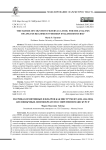
Статья научная
This study is devoted to the development of the author's method “The Matrix of Cognitive Filters” (MCF). It is used to model the process of inferring the meaning of creative elements (linguocreatemes) in multimodal online discourse. To accomplish this task, key cognitive mechanisms for generating the meaning of linguocreatemes were identified and researched. These are banner blindness, evaluative categorization and conceptualization, (de)compression of information and profiling, conceptual metaphor, conceptual metaphtonymy, and conceptual integration. Monomodal verbal and multimodal linguocreatemes (more than 18,000 units) were selected with a continuous sampling method from English-language Internet resources, visual and verbal corpora. Theoretical analysis showed that the MCF can be used to model the overall ability of a linguocreateme to initiate cognitive resonance in a recipient. This method also allows for the collection of data on the probabilistic prediction of the level of cognitive resonance and positive or negative dissonance in an addressee. The empirical data obtained during a practical linguistic-cognitive experiment among English-speaking respondents from across countries confirmed the theoretical results of the study. The participants had to infer the general meanings of several multimodal linguocreatemes in accordance with the MCF. The experiment confirmed the feasibility of using this method to assess the occurrence of cognitive resonance, positive or negative dissonance, as well as obtaining additional data on the recipient's reactions to different linguocreatemes in English online discourse.
Бесплатно
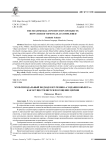
The multimodal constitution of objects: how church viewing is accomplished
Статья научная
Based on a single case analysis, this essay examines the question of what the structure of a church viewing is like. Within a theoretical framework which conceptualizes the church viewing as a cultural practice, “object constitution” is regarded as a central aspect and as a visitor ’s active achievement. For the composition of the church viewings corpus, visitors were not only filmed whilst walking through the church interior and visually perceiving certain aspects of the architecture, but were also asked to verbally comment their visual perceptions. The church viewing corpus was recorded with two cameras: an action camera, documenting from the church visitors’ perspective; the other a contextual camera following the visitors on their way through the church interior. This experimental design, which uses the verbal commenting of the visitors’ own perception as a scientific method, allows reconstructing their church viewing concepts as a dynamic interplay of their visual selection und perception of the church interior and the verbal commenting of their visual perception. The single case analysis proves that object constitution is in fact a visitor ’s active accomplishment by which parts of the church interior are brought forth in a new way: Anton, the analysed visitor, who examines in detail two large paintings hanging on the wall, constitutes them as “picture frames”.
Бесплатно
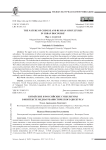
The nature of Chinese and Russian subcultures in urban discourse
Статья научная
The paper seeks to examine the communicative aspect of modern Chinese and Russian urban subcultures. The nominations of urban social groups representing young people in Russia and China and their connection to modern communication practices are viewed from the perspective of urban communication studies, which provides an opportunity for a new comprehension of issues connected with verbal and nonverbal constituents of urban discourse. The indicates that the subcultures in the Russian urban landscape are reflected in such nominations as фрики (freaki), мажоры (majory), хипстеры (hipstery), брейк-дансеры (break-dancery), байкеры (bikery), etc. The Chinese subcultures are known under such names as shamate, xiaoqingxin, tuyayawenhua, erciyuanyawenhua, egaoyawenhua and many others. We argue that in both countries the unity of social subgroups is based not so much on ideological preferences, but rather on lifestyles, hobbies and interests, many of them formed under the Western influence. The subcultures discussed in the research represent a broad panorama of Chinese and Russian social life. They reflect the sociocultural dynamics of attitudes, values and lifestyles influenced by globalization but acquiring nationally specific features, which transform them into unique sociocultural phenomena.
Бесплатно
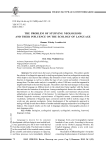
The problem of studying neologisms and their influence on the ecology of language
Статья научная
The article raises the issues of neology and ecolinguistics. The authors specify the criteria of ecolinguistic approach to studying neologisms based on ecolinguistic monitoring which helps to elicit factors that influence the formation of new words, spheres in which they function in language as well as to define the type of new words and number of loanwords among them. The data under analysis is compiled by about 3 000 new words that appeared in English and Dutch in the last three decades. The authors elicit the main changes in the ecology of the Dutch language on different levels in the stated time frame together with the factors that motivate the formation of neologisms. Among extralinguistic factors the authors list such determinants as the emergence of new realia; scientific and technical advancement; globalization and development of the Internet. To intralinguistic factors the following are referred: linguistic economy; expressiveness of linguistic means; systematization of the vocabulary; unification of linguistic signs; conversion and the shift in stylistic usage of the words can also generate neologisms. Future development of the ecolinguistic approach in neology will help to track the evolution of modern national language and preserve its ecolinguistic balance. The research results can be used in language education, lexicographic practice or state language policy.
Бесплатно
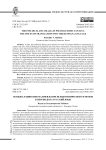
Статья научная
To date, the traditional fantasy genre that has its roots in European folklore is transforming as authors seek new, fresh mythological foundations and exotic forms of narration. In an attempt to conquer foreign markets, some of them deploy Slavic mythology and embed words of Slavic origin to create their magical worlds. However, the resulting product is often a Pan-Slavic fantasy universe that refers to no specific culture. In this research, 'pseudo-ethnics' denotes an exotic atmosphere created by words associated with a broad linguacultural cluster. The object of the study was the vocabulary used to denote pseudo-Slavic realities in the novel Shadow and Bone by Leigh Bardugo and its film adaptation, as well as the translation techniques employed by the Russian translators. Leigh Bardugo used pseudo-Russian anthroponyms, toponyms and words that denote everyday objects and magical creatures. They represent Latinized Russian borrowings and seemingly authentic neologisms that deploy some morphological and phonetic language features an English-speaking reader might associate with the Slavic culture. However, when translated for an audience with a Slavic ethnic background, the pseudo-ethnic fantasy book or film loses its exotic flavor. The translation techniques for Latinized Russian words conveying the pseudo-ethnic atmosphere are de-transliteration and de-transcription. As part of the translation, translators had to adhere to the grammar rules of the Russian language and eliminate grammatical errors in parts of speech or gender.
Бесплатно

![Splendours and miseries of total play in akunin’s literary oeuvre (book review: snigireva T. A. Boris akunin i ego igrovoy mir [tekst] : monografiya / T.A. Snigireva, A.V. Podchinenov, A.V. Snigirev. - saint petersburg : aleteya, 2017. - 178 P.) Splendours and miseries of total play in akunin’s literary oeuvre (book review: snigireva T. A. Boris akunin i ego igrovoy mir [tekst] : monografiya / T.A. Snigireva, A.V. Podchinenov, A.V. Snigirev. - saint petersburg : aleteya, 2017. - 178 P.)](/file/thumb/149129909/splendours-and-miseries-of-total-play-in-akunins-literary-oeuvre-book-review.png)
